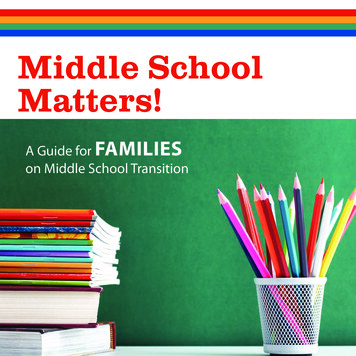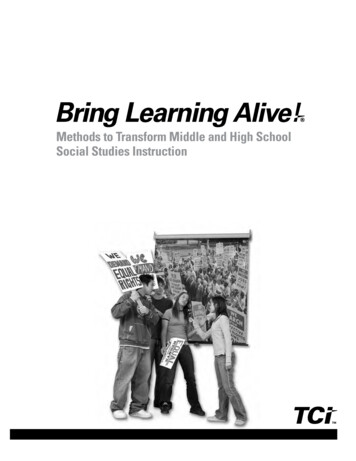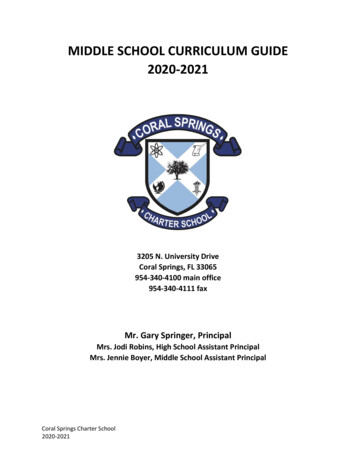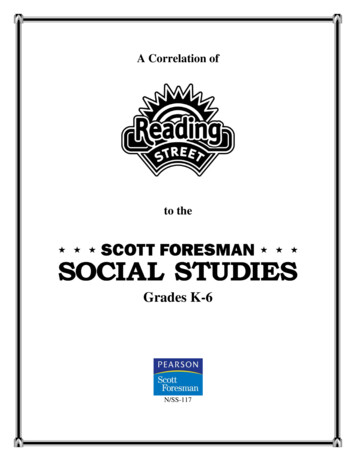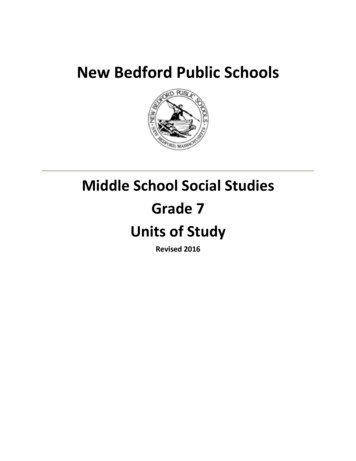
Transcription
New Bedford Public SchoolsMiddle School Social StudiesGrade 7Units of StudyRevised 2016
NBPS Middle School Scope and SequenceGrade 6- World GeographySixth graders study the world outside the United States and North America andsystematically learn geography around the world continent by continent, similarto the way in which atlases are organized. The students address standards thatembed five major concepts: location, place, human interaction with theenvironment, movement, and regions.Grade 7- Ancient CivilizationsThe curriculum for grade 7 is designed to provide students with an in-depthunderstanding of the major events, people, and movements that have shapedancient history commencing with the year 3000 B.C. and culminating with thesignificant events and people associated with the decline of the Roman Empire in550 A.D. Incorporated with the study of ancient history will be a study of worldgeography as it affected the development of ancient civilizations. This instructionwill be accomplished with the utilization of critical thinking skills, research withprimary source documents, and the use of project-based learning.Grade 8- Introduction to United States HistoryThe objective of the curriculum for grade 8 is to provide students with an in-depthunderstanding of the major events, people, and movements that have shapedAmerican history beginning with the Age of Exploration and continuing with astudy of the seventeenth century colonial settlements, the American Revolutionand the Constitutional Era. Emphasis in the course will be placed on thedevelopment of critical thinking skills, research with primary sources, and theutilization of project-based learning. Relevant United States geography wi9ll becorrelated with the historical events that have encompassed the period from theAge of Exploration through the Constitutional Era. This course will provide thestudents with the necessary foundation to be successful with the study of historyat the high school level.2
Grade 6- Units of StudyUnit124TitleMap Skills: South AmericaFive Themes of Geography: Europe and AfricaCivics, Government, and Economics: AsiaTime FrameSept- Nov (8-10 weeks)Dec-March (10-12 weeksApril-June(8-10 weeks)Grade 7- Units of StudyUnitTitleTime Frame1Human Origins in Africa through the Neolithic Age Sept (3-4 weeks)2MesopotamiaOct- Nov (6 weeks)3Phoenicia and Israel*Dec (2 weeks)4Egypt: An ancient river civilizationJan-Feb (8 weeks)5Ancient GreeceMarch-April (8weeks)6Ancient RomeMay-June (8weeks)*Phoenicia can be completed after Mesopotamia, and Israel after Egypt. It is asmall unit that can be divided and fit in appropriately.Grade 8- Units of StudyUnit123TitleAge of Exploration and ColonizationThe Birth of a Nation: The American RevolutionConstitutional Era3Time FrameSept- Nov (10 weeks)Dec-March (10-12 weeks)April-June(8-10 weeks)
Overarching Essential Questions:Along with essential questions connected to content units of study, overarchingskill-based and content related essential questions help vertically align ourcurrent middle school curriculum. These skills are not taught in isolation, but areembedded in the content. Many of these skills might be taught and reinforcedmultiple times within a unit, and throughout the year.Skill-Based Topics:Essential Questions:Researching: GatheringWhat do I need to know and how do I find it usingand evaluating sourcescredible and reliable sources?Synthesis: drawingWhat inferences, conclusions, decisions, and/orinformed conclusions topredictions can I make based on the informationcreate new understandingthat I have?Evaluating, Analyzing andHow do I use evidence that I found (to build andUsing Evidence:support a claim)?Social Studies Content:Essential Questions:CivicsWhat makes a good citizen?What are basic freedoms and rights all citizensshould have?Government and PoliticsHow are rules/laws/decisions made and why arethey important?How do different political systems develop andhow do they impact society?GeographyHow does where you live affect how you live?Why do people, goods or ideas move?How does geography affect growth anddevelopment of societies/communities?How do humans impact the physical and politicalworld?CultureWhat happens when cultures interact?4
Social Studies Vocabulary- The following is a list of essential vocabulary,additional vocabulary instruction should occur based on grade level, studentneed, and text eraerosionethnic groupgeographyglaciergovernmenthuman resourcehurricaneislandisthmuslinguistic grouplocationmonsoonmountainnationnatural resourceoceanpeninsulaphysical featuresplainplateau5politicsrain forestregionreligious ndraurbanizationwind currents
Unit or Topic: Unit 1Human Origins in Africa through theNeolithic AgeThis unit discusses Course/Subject: Ancient CivilizationsGrade Level: 7thTime Frame: 3-4 weeks- Paleolithic and Neolithic Ages- Metallurgy (technology)- Characteristics of civilizationsEstablished Goals:MA History Curriculum Framework:HUMAN ORIGINS IN AFRICA THROUGH THE NEOLITHIC AGE7.1 Describe the great climatic and environmental changes that shaped the earth andeventually permitted the growth of human life. (H)7.2 Identify sites in Africa where archaeologists have found evidence of the origins of modernhuman beings and describe what the archaeologists found. (G, H)7.3 Describe the characteristics of the hunter-gatherer societies of the Paleolithic Age (theiruse of tools and fire, basic hunting weapons, beads and other jewelry). (H)7.4 Explain the importance of the invention of metallurgy and agriculture (the growing ofcrops and the domestication of animals). (H)7.5 Describe how the invention of agriculture related to settlement, population growth, andthe emergence of civilization. (H)7.6 Identify the characteristics of civilizations. (H, G, E)A. the presence of geographic boundaries and political institutionsB. an economy that produces food surplusesC. a concentration of population in distinct areas or citiesD. the existence of social classesE. developed systems of religion, learning, art, and architectureF. a system of record keepingCCSS Reading for Literacy in History/Social Studies:RH.1: Cite specific textual evidence to support analysis of primary and secondary sources.RH.2: Determine the central ideas or information of a primary or secondary source; providean accurate summary of the source distinct from prior knowledge or opinionsRH.3: Identify key steps in a text’s description of a process related to history/social studies(e.g., how a bill becomes law, how interest rates are raised or lowered).RH.4: Determine the meaning of words and phrases as they are used in a text, includingvocabulary specific to domains related to history/social studies.6
RH.5: Describe how a text presents information (e.g., sequentially, comparatively, causally).RH.6: Identify aspects of a text that reveal an author’s point of view or purpose (e.g., loadedlanguage, inclusion or avoidance of particular facts).RH.7: Integrate visual information (e.g., in charts, graphs, photographs, videos, or maps) withother information in print and digital texts.RH.8:Distinguish among fact, opinion, and reasoned judgment in a text.RH.9: Analyze the relationship between a primary and secondary source on the same topic.CCSS Writing in History/Social Studies:WHST.1: Write arguments focused on discipline-specific content.a. Introduce claim(s) about a topic or issue, acknowledge and distinguish theclaim(s) from alternate or opposing claims, and organize the reasons andevidence logically.b. Support claim(s) with logical reasoning and relevant, accurate data and evidencethat demonstrate an understanding of the topic or text, using credible sources.c. Use words, phrases, and clauses to create cohesion and clarify the relationshipsamong claim(s), counterclaims, reasons, and evidence.d. Establish and maintain a formal style.e. Provide a concluding statement or section that follows from and supports theargument presented.WHST.2: Write informative/explanatory texts, including the narration of historical events,scientific procedures/ experiments, or technical processes.a. Introduce a topic clearly, previewing what is to follow; organize ideas,concepts, and information into broader categories as appropriate to achievingpurpose; include formatting (e.g., headings), graphics (e.g., charts, tables),and multimedia when useful to aiding comprehension.b. Develop the topic with relevant, well-chosen facts, definitions, concrete details,quotations, or other information and examples.c. Use appropriate and varied transitions to create cohesion and clarify therelationships among ideas and concepts.d. Use precise language and domain-specific vocabulary to inform about orexplain the topic.e. Establish and maintain a formal style and objective tone.f. Provide a concluding statement or section that follows from and supports theinformation or explanation presented.WHST.4: Produce clear and coherent writing in which the development, organization, andstyle are appropriate to task, purpose, and audience.WHST.5: With some guidance and support from peers and adults, develop and strengthenwriting as needed by planning, revising, editing, rewriting, or trying a new approach, focusingon how well purpose and audience have been addressed.WHST.6: Use technology, including the Internet, to produce and publish writing and presentthe relationships between information and ideas clearly and efficiently.WHST.7: Conduct short research projects to answer a question (including a self-generatedquestion), drawing on several sources and generating additional related, focused questionsthat allow for multiple avenues of exploration.WHST.8: Gather relevant information from multiple print and digital sources, using searchterms effectively; assess the credibility and accuracy of each source; and quote orparaphrase the data and conclusions of others while avoiding plagiarism and following astandard format for citation.WHST.9: Draw evidence from informational texts to support analysis, reflection, andresearch.7
WHST.10: Write routinely over extended time frames (time for reflection and revision) andshorter time frames (a single sitting or a day or two) for a range of discipline-specific tasks,purposes, and audiences.*Note: Students’ narrative skills continue to grow in these grades. The standards require thatstudents be able to incorporate narrative elements effectively into arguments andinformative/explanatory texts. In history/social studies, students must be able to incorporatenarrative accounts into their analyses of individuals or events of historical import. –Pg. 78Massachusetts Curriculum Framework for English Language Arts and Literacy, March 2011Resources:Textbooks:Ancient Civilizations Through the Renaissance, Holt McDougalChapter 2- The Stone Ages and Early Cultures- pg. 25-47Words to Know pg. H5Geography Review pg. 12-19Social Studies: Ancient Civilizations, Harcourt Braceo Chapter 1Supplemental Workbooks/ActivitiesEarly Human Migration MapDomestication MapEarly Hominid Fossil Site MapPrimary Sources:Caves of Lascaux, Stone tools, visuals of artifactsOnline Resources:Link to resources listed in lesson sequence:https://drive.google.com/open?id 0B8amFDr6vptQWmxTME95TUVUSjAhmhsocialstudies.com - online resource connected to text- contains an abundance ofuseful supplemental materialsStudents will understand that Content:Essential Questions to Guide Learning& InquiryU1. Geography can help shape a place’shistory.How does geographic location impactpeople?U2. The past can help people better understandthe present and plan for the future.How do historians and archaeologists useclues to understand how people lived inthe past?U3.Early humans depended on their naturalenvironment for food and shelter.U4. Prehistoric people learned to adapt to theirenvironment by creating simple tools, using fire,8How did prehistoric people use theresources in their environments to adaptand advance?
and language.U5. As people migrated around the world theylearned to adapt to new environmentsHow did the development of fire lead toprehistoric man migrating throughout theworld?U6. The development of agriculture broughtgreat changes to human societyHow did the development of farmingchange life for early man?What does the use of tools tell us about asociety?Reading and Writing:A text’s features, structure, andcharacteristics facilitate the reader’sability to make meaning of the text.Good readers compare, infer, synthesize,and make connections to make textrelevant and useful.Good writers develop and refine theirideas for thinking, learning, andcommunicatingA writer selects a form based onaudience and purpose.Oral discussion helps to buildconnections to others and createopportunities for learning.Students will know Students will be able to Content:Describe how the great climatic andenvironmental changes shaped the earthand eventually permitted the growth ofhuman life.The difference between primary andsecondary sourcesContent-specific vocabulary encountered inmultiple textIdentify the sites in Africa wherearchaeologists have found evidence of theorigins of modern human beings and beable to describe what the archaeologistsfound.Key content-specific vocabulary related tohuman origins and the Neolithic ageHow to determine a central theme or ideafrom piece of informational textDescribe the characteristics of the huntergatherer societies of the Paleolithic Ageand how they used tools and fire, basichunting weapons, beads and other jewelry.Describe how the invention of agriculture9
related to settlement, population growth,and the emergence of civilization.Identify the characteristics of civilizations.A. the presence of geographic boundariesand political institutionsB. an economy that produces foodsurplusesC. a concentration of population in distinctareas or citiesD. the existence of social classesE. developed systems of religion, learning,art, and architectureF. a system of record keepingLiteracyRead, analyze, and interpret primary andsecondary sources.Cite explicit and inferential textualevidence to support conclusions indiscussion and in writing.Read closely first with support and thenindependently for a specific purposerelated to the task.Determine the main idea of a text, andidentify aspects of the text that reveal theauthor’s point of view or purpose.Analyze and interpret various types ofmaps, charts, and graphs.Explain and apply content-specificvocabulary.Assess the credibility and accuracy ofsources.Use technology as a tool to research,organize, evaluate, and communicateinformation.Take notes and write, using quotes andparaphrasing, avoiding plagiarism andproviding bibliographic information.Raise, consider, discuss, read and write10
about key questions regarding humanoriginsMake judgments and decisions based onhistorical situations.Speak coherently and effectively presentinformation to a large groupPerformance TasksAssessment EvidenceOther Assessment EvidenceOn-going interactive notebook: Entrieswill include sections for each civilizationdocumenting countries, cities, bodies ofwater, landforms, key vocabulary,maps, and graphic organizers to notetake information.Students’ contributions anddemonstration of understanding duringdiscussions.Two-Column notes/T-chart used fornote taking, primary source analysis,pre-writing activities.Written responses to text-dependentquestions.Optional quizzes for vocabulary orcomprehension.Independent analysis of maps, charts,and graphs.Pre testPerformance Task #1: (See lesson 4)Students will complete a Venn diagramcomparing Hunter-gatherers to earlyfarmers (food producers). Using theevidence from the Venn diagram completea writing assignment that summarizes thelifestyles of early farmers to the lifestyle ofhunters and gatherers. Example prompt:o Early man transitioned from huntingand gathering their food, to producingit. Compare and contrast hunters andgatherers to early farmers.Task 2:o Characteristics of a CivilizationsFlip-Book (Lesson 5)Key Criteria for Performance AssessmentKey Criteria for Other AssessmentsWritten answers should include evidencefrom the text to support student answers.Writing rubrics should be used to assessthe learning on all performance tasksLogical and comprehensible ideadevelopmentTextual evidence from the text usedappropriately and accuratelyUse of standard English conventions inwriting and speakingProficient use of content-specificvocabulary and map skillsPossible Accommodations – PerformancePossible Accommodations – other11
taskScaffold learning tasks for struggling studentsby dividing parts of the assessment into smallerwork tasks.Provide graphic organizers to assist with writingtasks and student checklists to self-monitor.assessmentsProvide audio and visual access to supporttext comprehension for struggling learners.Provide an outline or summary of the text.Anchor Charts for Student ReferenceDifferentiate close reading by reducing thenumber of paragraphs and practicingongoing assessment of student progressto inform decisions about the students thatneed additional support.Apply RETELL strategies for ELL studentsProvide direct instruction of vocabulary:Provide a description, explanation,or example of the new term.Ask students to restate thedescription, explanation, orexample in their own words.Ask students to construct a picture,pictograph, or symbolicrepresentation of the term.Engage students periodically inactivities that help them add to theirknowledge of the terms throughstudents discourse and writtenwork.Periodically ask students to discussthe terms with one another.Learning PlanSummary of Key Learning Events and InstructionIn general:Define vocabulary using context cluesClose reading (supported and then independent) with text-dependent questions to usewith individuals and groupsDiscussion in various modes (turn and talk, small group, think/pair/share, whole group,jigsaw)Text-Dependent QuestionsDirect Instruction in analysis of primary and secondary sourcesDirect instruction in key vocabularyDirect instruction in writing** Lessons are organized into topics and some are meant to extend over the course of12
several daysLesson 1: Exploration of Essential Questions (The unit should be “bookended” by anessential question exploration session, meaning that you begin exploring the essentialquestions and end the unit by looking at them again and reexamine them as a class and incollaborative groups. Throughout the unit, teachers should refer back to essential questionsand encourage students to consider them throughout the unit.)Students can examine questions through collaborative groups, think-pair-shareactivities, journal writing or other such collaborative activities that help studentsengage in academic discourse.Geography Review: Physical and human geography contribute to the study ofhistory. Geography affects resources, shapes culture, and influences history.Lesson 2: The First PeopleKey Vocabulary: prehistory, hominid, ancestor, tool, Paleolithic Era, society, huntergatherers, history, historians, archaeology, archaeologists, fossil, artifacts, primarysource, secondary source)Student will read pages 28-34 in text “Ancient Civilizations: Through the Renaissance.Answer guided reading questions; Section 1 assessment.Students will respond to one of the following prompts using vocabulary terms;Imagine an unexpected mudslide buried your house and its contents. Two hundred years laterthe site is dug up by archaeologists. Tell which artifacts in your house will have survived;explain why. What might have happened to any bodies buried in the mudslide?Create map of : Early Hominid Fossil Site MapRead from online text resource: The Stone Ages and Early Cultures: Primary Source- TheDiscovery of Chauvet CaveLesson 3: Early Human MigrationKey Vocabulary; ancestor, society, culture, hunter-gatherers, migrate, ice ages, landbridge.Students will read pages 36-39 in text “Ancient Civilizations: Through the Renaissance”Answer guided reading questions Unit 2 assessment.Students will complete an Archaeological dig activity in which they will identify items asbeing either artifacts or fossils, and what their possible uses could have been to the“early” people they came from (a box with various items, and fossils will be given to eachgroup to exam, identify and record on the attached chart) (see Google docs link)Lesson 4: Beginnings of AgricultureKey Vocabulary; domestication, agriculture, development, megaliths, livestock, produceStudents will read pages 40-43 in text “Ancient Civilizations: Through the Renaissance”.Answer guided reading questions Unit 3 assessment.Students will read and respond to text based questions about “Skara Brae” (HarcourtBrace book pages 72-76).13
Students will read the web based article “The Agricultural Revolution”, annotate the text,and answer the reading comprehension questions that go along with it. (see Google docslink)Complete text supplemental resource: The Stone Ages and Early Cultures: History andGeography- Agriculture and AnimalsPerformance Task #1: Students will complete a Venn diagram comparing Huntergatherers to early farmers (food producers). Using the evidence from the Venn Diagramcomplete a writing assignment that summarizes the lifestyles of early farmers to thelifestyle of hunters and gatherers. Example prompt:Early man transitioned from hunting and gathering their food, to producing it.Compare and contrast hunters and gatherers to early farmers.Lesson 5: Characteristics of a CivilizationKey Vocabulary terms; civilization, urban areas, monuments, division of labor, socialclasses, written communication.Students will read “Characteristics of a Civilization” article (see attached). They willdefine their key vocabulary terms from the article, the ill take two column notes from thearticle, and they answer reading comprehension questions that go along with the article.Students will create a flip chart that displays the characteristics of civilization including adefinition, example, and picture for each.Lesson 6: Revisit Essential Questions and goals for the unit.14
Unit or Topic: Unit 2MesopotamiaMesopotamia: Site of Several AncientRiver Civilizations, c. 3500-1200 BC/BCEGeographic location shapes thedevelopment of Mesopotamia (TheTigris and Euphrates Rivers andthe Fertile Crescent)Polytheistic beliefsInventions and InnovationsHammurabi and His Code of LawsCourse/Subject: Ancient CivilizationsGrade Level: 7thTime Frame: October – November(8 weeks)Established Goals:MA History Curriculum Framework:Mesopotamia: Site of Several Ancient River Civilizations, c. 3500-1200 BC/BCE7.7 On a historical map, locate the Tigris and Euphrates Rivers and identify Sumer,Babylon, and Assyria as successive civilizations and empires in this region, andexplain why the region is sometimes called “the Fertile Crescent.” On a modern mapof western Asia, identify the modern countries in the region (Iraq, Iran, and Turkey).(H, G, E)7.8 Identify polytheism (the belief that there are many gods) as the religious belief ofthe people in Mesopotamian civilizations. (H)7.9 Describe how irrigation, metalsmithing, slavery, the domestication of animals,and inventions such as the wheel, the sail, and the plow contributed to the growth ofMesopotamian civilizations. (H, E)7.10 Describe the important achievements of Mesopotamian civilization. (H, C, E)a. its system of writing (and its importance in record keeping and tax collection)b. monumental architecture (the ziggurat)c. art (large relief sculpture, mosaics, and cylinder seals)7.11 Describe who Hammurabi was and explain the basic principle of justice inHammurabi’s Code (“an eye for an eye”). (H, C, E)CCSS Reading for Literacy in History/Social Studies:RH.1: Cite specific textual evidence to support analysis of primary and secondarysources.RH.2: Determine the central ideas or information of a primary or secondary source;15
provide an accurate summary of the source distinct from prior knowledge or opinionsRH.3: Identify key steps in a text’s description of a process related to history/socialstudies (e.g., how a bill becomes law, how interest rates are raised or lowered).RH.4: Determine the meaning of words and phrases as they are used in a text, includingvocabulary specific to domains related to history/social studies.RH.5: Describe how a text presents information (e.g., sequentially, comparatively,causally).RH.6: Identify aspects of a text that reveal an author’s point of view or purpose (e.g.,loaded language, inclusion or avoidance of particular facts).RH.7:Integrate visual information (e.g., in charts, graphs, photographs, videos, or maps)with other information in print and digital texts.RH.8:Distinguish among fact, opinion, and reasoned judgment in a text.RH.9: Analyze the relationship between a primary and secondary source on the sametopic.CCSS Writing in History/Social Studies:WHST.1: Write arguments focused on discipline-specific content.f. Introduce claim(s) about a topic or issue, acknowledge and distinguish theclaim(s) from alternate or opposing claims, and organize the reasons andevidence logically.g. Support claim(s) with logical reasoning and relevant, accurate data andevidence that demonstrate an understanding of the topic or text, usingcredible sources.h. Use words, phrases, and clauses to create cohesion and clarify therelationships among claim(s), counterclaims, reasons, and evidence.i. Establish and maintain a formal style.j. Provide a concluding statement or section that follows from and supports theargument presented.WHST.2: Write informative/explanatory texts, including the narration of historical events,scientific procedures/ experiments, or technical processes.g. Introduce a topic clearly, previewing what is to follow; organize ideas,concepts, and information into broader categories as appropriate toachieving purpose; include formatting (e.g., headings), graphics (e.g.,charts, tables), and multimedia when useful to aiding comprehension.h. Develop the topic with relevant, well-chosen facts, definitions, concretedetails, quotations, or other information and examples.i. Use appropriate and varied transitions to create cohesion and clarify therelationships among ideas and concepts.j. Use precise language and domain-specific vocabulary to inform about orexplain the topic.k. Establish and maintain a formal style and objective tone.l. Provide a concluding statement or section that follows from and supportsthe information or explanation presented.WHST.4: Produce clear and coherent writing in which the development, organization,and style are appropriate to task, purpose, and audience.WHST.5:With some guidance and support from peers and adults, develop andstrengthen writing as needed by planning, revising, editing, rewriting, or trying a newapproach, focusing on how well purpose and audience have been addressed.WHST.6: Use technology, including the Internet, to produce and publish writing andpresent the relationships between information and ideas clearly and efficiently.16
WHST.7: Conduct short research projects to answer a question (including a selfgenerated question), drawing on several sources and generating additional related,focused questions that allow for multiple avenues of exploration.WHST.8: Gather relevant information from multiple print and digital sources, usingsearch terms effectively; assess the credibility and accuracy of each source; and quoteor paraphrase the data and conclusions of others while avoiding plagiarism andfollowing a standard format for citation.WHST.9: Draw evidence from informational texts to support analysis, reflection, andresearch.WHST.10: Write routinely over extended time frames (time for reflection and revision)and shorter time frames (a single sitting or a day or two) for a range of discipline-specifictasks, purposes, and audiences.*Note: Students’ narrative skills continue to grow in these grades. The standards requirethat students be able to incorporate narrative elements effectively into arguments andinformative/explanatory texts. In history/social studies, students must be able toincorporate narrative accounts into their analyses of individuals or events of historicalimport. –Pg. 78 Massachusetts Curriculum Framework for English Language Arts andLiteracy, March 2011Resources:Holt McDougal: World History; Ancient Civilizations Through the RenaissanceChapter 3: Mesopotamia and the Fertile Crescent- pgs. 50-81Harcourt Brace: Social Studies; Ancient Civilizations – pgs. 327-365Online ResourcesLink to resources listed in lesson sequence:https://drive.google.com/open?id s.com/- online resource connected to text- contains anabundance of useful supplemental sopotamia.co.uk/menu.htmlPrimary Sources:Hammurabi’s Codefrom the Epic of Gilgamesh pg. 70-71Students will understand that Content:Essential Questions to Guide Learning& Inquiry17
Technology changed life inMesopotamiaThe development of a writing andrecord system led to Hammurabi’sCode of Laws.Reading and Writing:A text’s features, structure, andcharacteristics facilitate the reader’sability to make meaning of the text.Good readers compare, infer,synthesize, and make connections tomake text relevant and useful.Good writers develop and refine theirideas for thinking, learning, andcommunicatingA writer selects a form based onaudience and purpose.Oral discussion helps to buildconnections to others and createopportunities for learning.Students will know Important achievements ofMesopotamian civilization.Who Hammurabi was and explain thebasic principle of justice inHammurabi’s CodeHow to apply geography skills, andcompare historical maps from ancientcivil
Overarching Essential Questions: Along with essential questions connected to content units of study, overarching . Social Studies Vocabulary- The following is a list of essential vocabulary, additional vocabula


